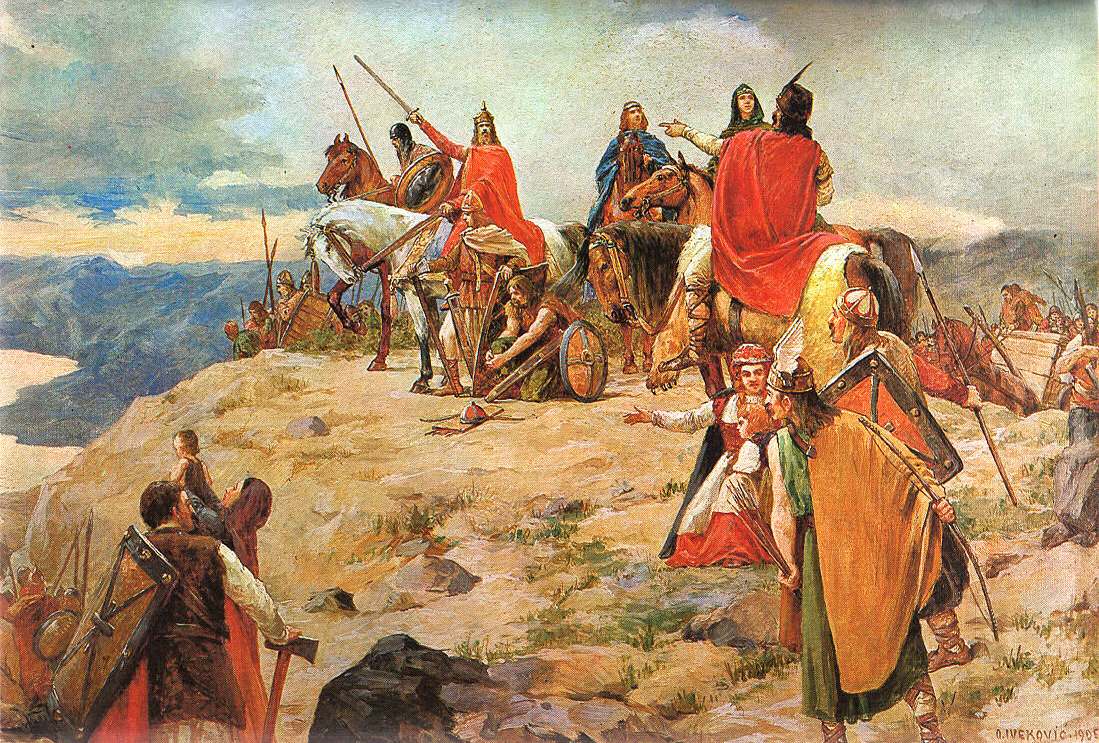The article below by Samar Abbas entitled “Identity of Croatians in Ancient Iran” was originally posted on the Iran Chamber Society website. Kavehfarrokh.com places this article for readers to generate questions, discussion and further research. Readers may also wish to consult the symposium proceedings at Zagreb on the subject of Croatian links with ancient Iran by accessing the following link through the Iran Chamber of Commerce venue:
- http://www.iranchamber.com/history/articles/pdfs/iranian_origin_croats.pdf
Kindly note that the pictures/illustrations and accompanying descriptions do not appear on the original Iran Chamber Society website.
==================================================
To date, 120 Croat and non-Croat university professors and several academics have compiled 249 research works of which many have been printed in various publications and thereby have proven that Croats are of Iranian origin.
There are many real evidences about the identity of ancient Croats which all dismiss the theory that Croats are of Slav origin. Although research works on the Iranian origin of the Croats could not be publicized due to the censorship that was widely practiced at the time of the former regime in Yugoslavia, however, the available documented evidences reveal that the initiator of the effort on research about the Iranian origin of the Croats lived two centuries ago.
In his thesis in 1797, the researcher made a study on the Iranian origin of the Croats and reached the conclusion that the present day Croats migrated from the western part of ancient Iran.
Following the formation of Yugoslavia in 1918, the bigot Slavs known as the “wolves” collected the original copies of the research work and destroyed them in an attempt to conceal the truth about the Iranian origin of the Croats. To date, only some part of the research work that has been quoted in a report prepared by the academy of sciences of former Yugoslavia in 1938 is available.
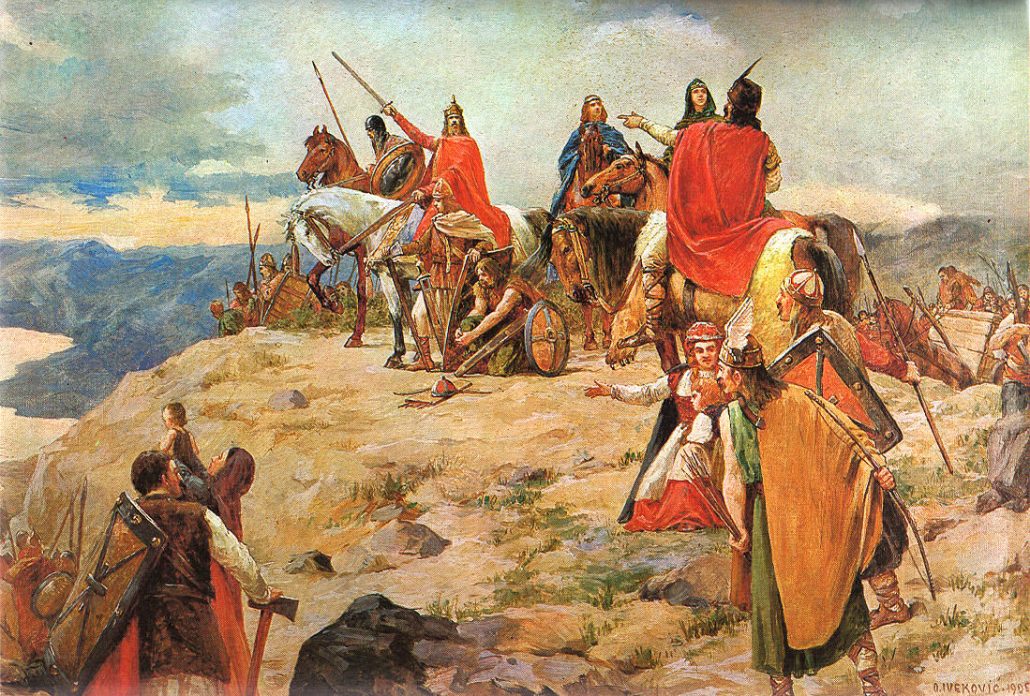
Oton Iveković’s (1869-1939) painting in 1905 entitled “The Coming of the Croats to the Adriatic” (Source: Public Domain).
One of the articles has quoted some police reports that the then government in former Yugoslavia mounted pressures on Iranologists within the period 1918 to 1990. The article further proves that upon official instructions by the then government, Croats had to be considered as the middle ages Slavs. For this same reason, all the research works conducted over the origin of the Croats were considered as criminal acts and thus prohibited for a period of 70 years. All the research papers compiled by Iranologists were confiscated as documents against state interests and the researchers were imprisoned or sent to detention camps. Even four researchers were killed by the Yugoslav secret police for making investigations over the issue.
However, there are other research works proving that 75 percent of the Croats are different in origin from the Slavs and more similar to Kurds and Armenians from genetic point of view. On the other hand, studies show that there are less similarities between domestic livestock, poultry and plants in the old time Croatia with those in Europe, lending further proof to the fact that Croats had most probably migrated from a region close to Asia to their present area.
Former Croat homeland and their migration
A manuscript dating back to 1370 B.C. has named the present day Croats and their language as Hurrvuhe (resembling Hrvati).
In the era of the Achaemenid, especially at the time of Cyrus II and Darius I, the name of the eastern Iranian province Harauvatya and the Croats of the ancient Iran Harauvatis and Harahvaiti have been mentioned for 12 times. In addition, two unearthed manuscripts belonging to the Croats living in the second and third centuries B.C. in ancient Iran have referred to the inhabitants of Horooouathos and Horoathoi. In the year 418, the Aryans were dubbed as Horites and Zachariasrhetor, in 559 the Aryan horse riders were referred to as Hrwts who lived in the vicinity of Krima and Azova and in the 7th century Croats were called as Slavs.
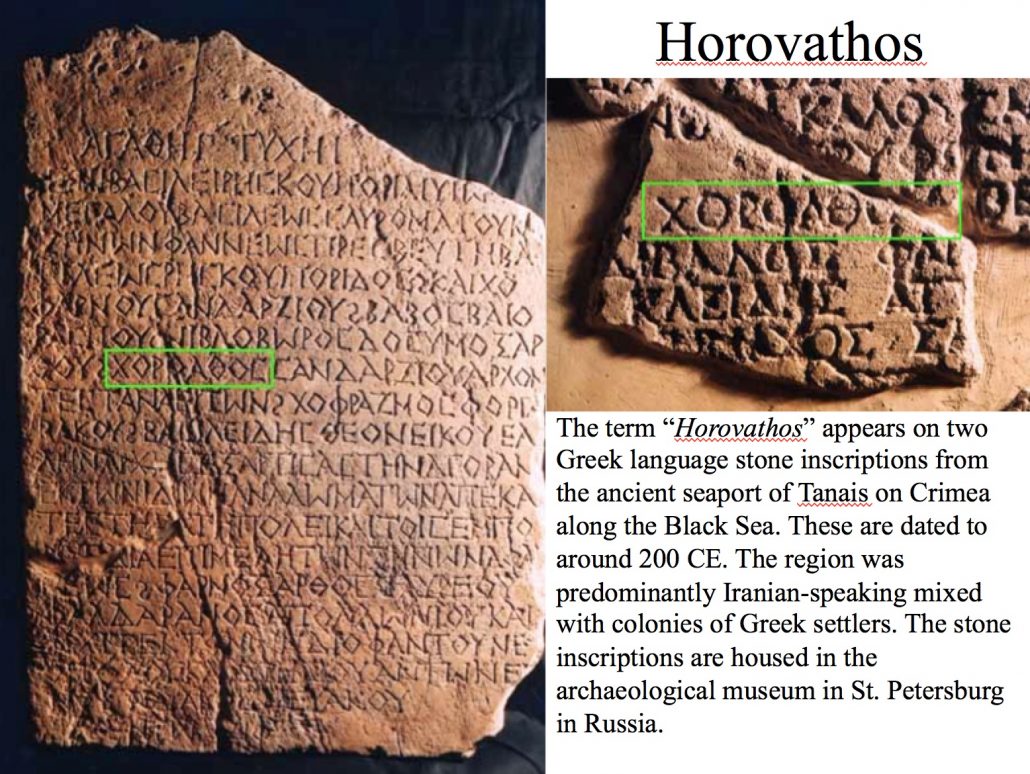
Lecture slide by Kaveh Farrokh prepared for lectures delivered through the University of British Columbia Continuing Studies Division. The images of the inscriptions are from Croatianhistory.net …
Other articles offered to the symposium discussed formation of the empire at the time of Cyrus the Great, history of the Croats in ancient Iran and Croat’s development from the time of ancient Indians to the time of their migration in the middle ages from the Caucasus through ancient Persian to the present Adriatic and emergence of the first traces of Croats which could be classified as follows:
- Harahvaiti and Harauvati in Iran and Afghanistan
- Hurravat and Hurrvuhe in Armenia and Georgia
- Horoouathos in Azova and the Black Sea
- Present day Croats Horvati and Hrvati along the Adriatic
First contacts between old-time Slavs and Croats of ancient Iran
Research works have been conducted on the relationship between the language spoken by the Croats and the language the present-day Slavs speak with an aim to identify the possible similarities. However, the studies do not dismiss the possibility that the old-time Croats were part of the ancient Iran at the time of the Persian Empire who later migrated to Europe and their language was changed into the Slav.
Meanwhile, studies on the Croats indicate that the old-time Slavs did not share the same race with the East European nations and that with the migration of the Croats with the Iranian origin, they established common cultural and lingual ties with each other.
Ties with the old-time Slavs in the 4th century was first established in the Red Croatia under the title Sarmatskim-Horitima and also after the 6th century in the realm of the Carpathians within the boundaries of the Great, or White, Croatia under the patronage of the Iranian Croats who had been turned Slavs due to the largeness of the population of the Slavs.
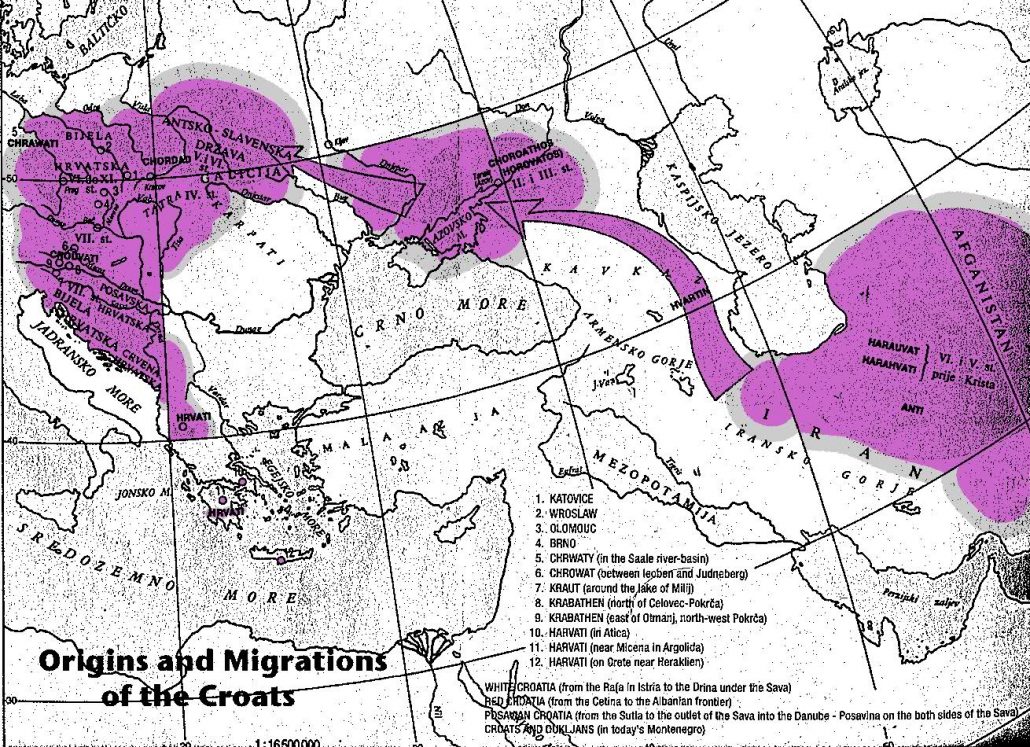
A theoretical map of Croation migrations (Source: Erepublic)
Iranology and old-time language of Croats
Studies show that there had been various stages in which the Croats had been pressured for accepting the language of the Slavs and annexation to former Yugoslavia. The idea was realized by the Serb nationalist Karadzic whose slogan was “Serbs everywhere”. He invited all bigot Slavist Serbs to the Vienna Congress in the middle of the 19th century for a political and lingual consensus and for adopting policies for the future of former Yugoslavia. In the aftermath of the agreements reached in the gathering and from 1890 the pro-Karadzic Slavists launched their activities for the elimination of all signs of cultural and lingual differences between the Serbs and the Croats. To this end, they changed the past history of the Croats and eliminated all the terms with Indo-Iranian roots that did not exist in the Serbian language. Such a trend continued until 1918 when Yugoslavia was formed.
The process for the change of the spoken language of the Croats of ancient Iran to the language of Slavs that was started in the 7th century continued up to the 20th century and was forcefully followed by former Yugoslavia.
Mazdaism, ancient myths and religion of Croats
In addition to similarities in language, common cultural points can be pointed out as well. For example, reference can be made to the symbols belonging to the old-time Christians that resembled symbols of Mazdaism in the ancient Iran.
A study in this connection has drawn a parallel between the language used in Bosnia and littoral states and islands of the Adriatic Sea in two separate sections. The study further elaborates how followers of Mazda in ancient Iran converted to Christianity in Europe and how Mazdaism was spread in Europe by the migration of the inhabitants of the above-mentioned areas.
Other research works have studied the influence of traditions in ancient Iran on the symbols of the roots of old Christianity from the ancient time to the middle ages.
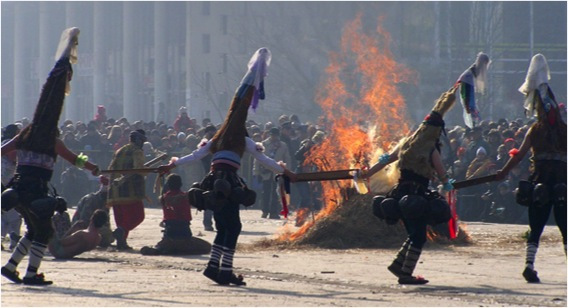
Legacy of ancient Iran in Europe: celebration of “Surva” in modern-day Bulgaria. Local lore traces this festival to the Iranian God Zurvan. This folklore system appears to be linked to the Bogomil movement. Interestingly, much of the Surva theology bears parallels with elements of Zurvanism and Zoroastrianism (Picture Source: Surva.org).
Identity of old-time Croat tribes
Research works conducted in the past decade discuss the similarities between names and families used in the ancient-time Iran and the names and families in present Croatia. Some of these studies have pointed to the roots of alphabetic letters in the Croat language and stressed that contrary to the claims of the Slavs the roots of those letters are totally oriental and widely used at ancient times. Many manuscripts written with those letters date back to before 9th century.
Research studies on the style of dressing of the Croats show that they were dressed up as the Sassanid and most of the local costumes of women were exactly similar to those worn by women at the time of the ancient Iranian empire.
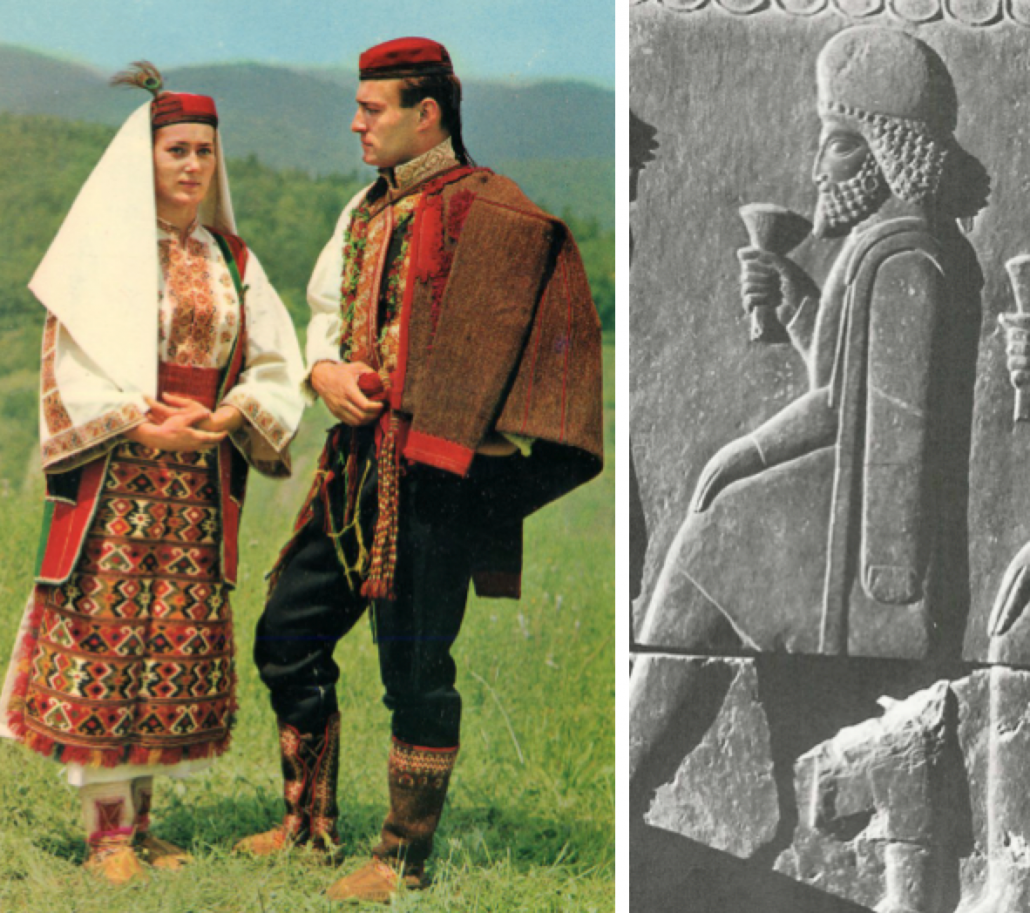 (Left) Traditional Croat attire (Source: Folk Costume) and (Right) Mede nobleman at Persepolis (Source: Photo by Moradi, 1971). The lady’s embroidery is almost identical to that seen among tribal elements in Iran, notably Kurds and Lurs. Her shirt bears striking parallels to those produced by the Kurds of Khorasan in NE Iran and the front panel of her skirt also found among Iran’s tribal elements. Her cap features a peacock feather; the peacock is a sacred entity in ancient Iranian mythology, as seen among present-day Yezidi Kurds. The gentleman’s attire has stylistic parallels among Iran’s nomadic tribes, with his boots reminiscent of ancient soft Iranian riding boots. Of interest is also the man’s ancient Iranian Kandys slung over his shoulder: the Kandys was a sign of nobility in ancient Persia as seen among the Perso-Mede nobility of Persepolis of the Achaemenid Empire thousands of years ago in the 6th – 5th Centuries BCE. The Kandys is also seen among Gothic nobles from the 5th century CE.
(Left) Traditional Croat attire (Source: Folk Costume) and (Right) Mede nobleman at Persepolis (Source: Photo by Moradi, 1971). The lady’s embroidery is almost identical to that seen among tribal elements in Iran, notably Kurds and Lurs. Her shirt bears striking parallels to those produced by the Kurds of Khorasan in NE Iran and the front panel of her skirt also found among Iran’s tribal elements. Her cap features a peacock feather; the peacock is a sacred entity in ancient Iranian mythology, as seen among present-day Yezidi Kurds. The gentleman’s attire has stylistic parallels among Iran’s nomadic tribes, with his boots reminiscent of ancient soft Iranian riding boots. Of interest is also the man’s ancient Iranian Kandys slung over his shoulder: the Kandys was a sign of nobility in ancient Persia as seen among the Perso-Mede nobility of Persepolis of the Achaemenid Empire thousands of years ago in the 6th – 5th Centuries BCE. The Kandys is also seen among Gothic nobles from the 5th century CE.
Studies on other features of the Croats such as navigation reject the Slav presumption that the Croats had not have navigated before but that they had rather learned the art from the Italians. According to the studies, there are evidences available that the Croats were acquainted with sailing even before the Slavs and that the time for their navigation in the Adriatic goes back to the 6th and 7th centuries. It should be noted that local Croat navigators were known as “Indo-Iranian” and “Slavs” in the Adriatic.

